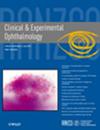Progression of diabetic retinopathy in women with pregestational diabetes during pregnancy and postpartum
Abstract
Background
Diabetic retinopathy (DR) may worsen during pregnancy, but its course in the postpartum remains poorly understood. Understanding the natural history of DR during and after pregnancy can help determine when sight-threatening DR treatment should be administered.
Methods
A prospective longitudinal cohort study recruited pregnant women with pre-existing type 1 (T1D) or type 2 diabetes from two tertiary Diabetes Antenatal Clinics in Melbourne, Australia. Eye examination results in early pregnancy, late pregnancy, and up to 12-months postpartum were compared to determine DR changes. Two-field fundus photographs and optical coherence tomography scans were used to assess DR severity.
Results
Overall, 105 (61.4%) women had at least two eye examinations during the observation period. Mean age was 33.5 years (range 19–51); 54 women (51.4%) had T1D; 63% had HbA1c <7% in early pregnancy. DR progression rate was 23.8% (95% CI 16.4–32.6). Having T1D (RR 4.96, 95% CI 1.83–13.46), pre-existing DR in either eye (RR 4.54, 95% CI 2.39–8.61), and elevated systolic blood pressure (adjusted RR 2.49, 95% CI 1.10–5.66) were associated with increased risk of progression. Sight-threatening progression was observed in 9.5% of women. Among the 19 eyes with progression during pregnancy, 15 eyes remained stable, three eyes progressed, and only one eye regressed in the postpartum.
Conclusions
Nearly 1 in 4 women had DR progression from conception through to 12-months postpartum; almost half of these developing sight-threatening disease. DR progression occurring during pregnancy was found to predominantly remain unchanged, or worsen, after delivery, with very few eyes spontaneously improving postpartum.

 求助内容:
求助内容: 应助结果提醒方式:
应助结果提醒方式:


